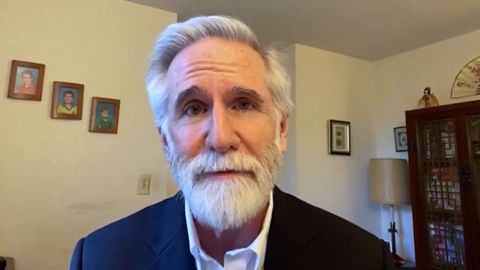Read Transcript EXPAND
BIANNA GOLODRYGA: Well, we turn now to the supply chain crisis crippling the U.S. Think overflowing ports, trucks queuing for miles, empty shelves and the rising price of goods, all this as the holiday season inches closer. David J. Lynch is a correspondent at “The Washington Post” and his new piece digs into the chaos unfolding in the shipping lanes and the economic fallout. Here he is talking to Hari Sreenivasan about where it all within the wrong and if it’s fair to lay the blame at Biden’s feet.
(BEGIN VIDEO CLIP)
HARI SREENIVASAN: Bianna, thanks. David Lynch, thanks for joining us. All right. Let’s sort of go through the links in this chain, as you do in one of the stories you have written, and it’s fascinating. I think most people don’t recognize how kind of perfectly timed everything has to be to get where we expect it to get. So, kind of begin — kind of when somebody makes a product, let’s say it’s overseas somewhere, where does the product go to first on that chain?
DAVID J. LYNCH; GLOBAL ECONOMIC CORRESPONDENT, THE WASHINGTON POST: Sure. Well, if you think about a factory in China or Vietnam, it comes out of the factory gate on a truck and it heads off to the port. You know, it could be the Port of Yantian or Ningbo in China. And it’s loaded in a shipping container, the standard metal rectangular box that we’re all familiar with and they really revolutionized global trade over the last several decades. And it’s loaded aboard, one of these massive container ships that can hold tens of thousands of these shipping containers. And then, the boat heads off from Asia towards the West Coast in the United States.
SREENIVASAN: And in that process along, you’ve already started to chronicle significant pressure points in the system. Talk about, for example, the containers. What does it cost now to get a container to haul your stuff, considering there’s so many out there waiting outside of ports?
LYNCH: Yes. The cost and availability of containers has become a problem over the past year, year and a half. And the system has really sort of been overwhelmed by both the pandemic and the changes in American consumption patterns that have resulted from that. So, if you think of the supply chain, normally it flows like a river, it moves in a very fluid way. These products come out of Asia and they cross the ocean, the boats sail right up to the dock, they are unloaded and then, the next link on the chain, the trucker picks it up and takes it off to union site. But at the moment, none of that synchronized operation is working the way it should. And it’s because it was optimized or set up for the economy of early 2020, and we don’t have that economy anymore. We are buying — all of us collectively are buying more physical products during this work from home era. We’re all buying furniture and laptops and lamps and computers and iPhone and we’re spending less comparatively at restaurants and ballparks and concerts and airline tickets. And so, that change in consumption patterns has really ramped up the demand on the pipeline, on the supply chain in a way that it simply can’t handle. And you see that in the cost of containers, in the cost of moving them across the ocean, which from Asia to the U.S. doubled between July in the end of the year after having already doubled between January and July. So, for a lot of importers, this is really becoming a crisis because the cost — their freight costs, in some cases, exceed the value of what they are shipping.
SREENIVASAN: I also want to ask, how much has the expectation creep as consumers that we have built into this system, how much of that is that contributing? Meaning, my interest in having something in my hand in two days is primarily a function of how Amazon has trained me that I can have almost anything in two days. What kind of a strain does that put on this whole system, because I wasn’t used to having everything in two days by nature?
LYNCH: Right. Well — and it is sort of a two-way process because not only do you want to have that product shipped directly to your front door, you know, you don’t want to go down to Macy’s or L.L.Bean and buy your new shirt. You want the new shirt sent straight to your door. So, that means when the shipping container, in the old days, the road used to go straight to that retailer. And then, it would be disassembled and put on the shelves and you would have to g pick it up. Now, before the container gets to the retailer, it has to be stopped at a separate facility and that box is broken up, instead of the box going to L.L.Bean, it’s now going to a hundred or maybe thousand different addresses. So, it complicates things on that end. And then, you also have the expectations of a consumer that when the shirt arrives at your house and you pull it out and you try it on and say, gee, actually, these stripes make me look fat or I don’t like this color after all or the sleeves are too long, now, I want to send it back. And so, that’s put a lot more demand, again, coming from tens, hundreds, thousands of individual locations instead of the comparatively rare occurrence of it coming from the retailer, right? Because you would have gone in, tried it on at Macy’s or Nordstrom’s of L.L.Beans and recognized there in the store that it didn’t fit and you would have left it and walked away and somebody else would have bought it. But now, you want to be able to ship it back yourself, and so, that’s put added strain on the system.
SREENIVASAN: You know, we had heard in the news that the president had asked for kind of 24/7 operations at the ports down in Southern California. Is that helping? Did that work?
LYNCH: Well, it’s important to be precise about what this means. Because the administration has billed this as 24/7 operations at the ports. And that’s not really what’s happening. There’s been a pilot program that’s Port of Long Beach at one terminal. There are multiple terminals. Think of it like airport terminals for passengers. There are terminals at the port for cargo. And one of six, I think, terminals at Long Beach is operating 24/7, and that’s four days a week. So, it’s really 24/4. At the Port of Los Angeles, which was the new announcement a couple weeks ago, the details of that still haven’t been within released. So, it’s not clear how many of those terminals are operating 24/7. So, put those details aside for a moment. Even when the terminals are running flat out or are open, let’s say, around the clock, that doesn’t mean anything is happening at 3:00 a.m. If you’re a truck driver, you know, and you show up at 3:00 a.m. even if we assume you can find the chassis that you need to pick up the container, where are you going to take it at 3:00 in the morning? You know, the Walmart distribution site might not be open. The Target site might not be open. And time is money for these truckers. So, they can’t afford to pick up a container, even if it’s easier at 3:00 in the morning, and then go kill two or three hours somewhere else waiting to drop it off.
SREENIVASAN: You even chronicled the story of a trucker who has had so much idle time on his hands, that — well, tell me a little bit about the guy that you met.
LYNCH: Yes. A very nice guy, Alvaro Ramirez (ph). We met out in Joliet, Illinois. Veteran truck driver. And owner/operator of a big rig. And he needs to make six or seven turns or round trips a day between customer warehouses and the local rail yard, which is a big facility run by Union Pacific out there outside of Chicago. This is a critical hub in the whole freight chain. But with the congestion being what it’s been at the rail yards, which is, you know, another link in the chain, congested all the way back to Asia, he was downed to one or two turns a day. So, he switched to driving the night shift to make it a little bit better, but he’s still killing so much time that he’s watching Conan O’Brien comedy bits or listening to podcasts. And then, at one point it got so bad he started watching YouTube videos of how to dance the salsa to improve his social life. And he said he started knowing nothing about it. And by this point he’s quite accomplished salsa dancer because he’s been wasting so much time in line.
SREENIVASAN: In your reporting, did you find that labor or shortage of labor had any part to do with this?
LYNCH: Yes, you hear that a lot, particularly in the trucking business, which is a situation, I think, that predated the pandemic concerns over adequate numbers of truckers. But it’s really come into focus in this period. And, you know, the trucking companies will tell you, they’re just have difficulty attracting the next generation of truckers, that there’s a lot of guys my age or maybe in their 50s who are out there and are used to the lifestyle and have made a good living at it over the years, but the younger cohort, the 20-25-year-olds, they are not as interested in this type of work. And particularly, their time on the labor market is red hot. And there are plenty of opportunities for somebody, you know, to work in other fields if they are inclined to. And for a lot of folks, they are thinking particularly when you think about Mr. Ramirez, you know, wasting all that time in line and seeing his wages suffer, you know, that doesn’t help attract people.
SREENIVASAN: You know, it seems the pandemic has kind of, in so many different aspects of our life, revealed flaws that we have sort of papered over. I mean, besides the pandemic, were there other forces that were contributing to all of the stresses that were in the system and are we just kind of seeing this now?
LYNCH: Yes. I think that’s the right way to think about this. The pandemic has been the stress test for our economy. It’s been a stress test for the way we organize our supply chain cans. And it has illuminated some weaknesses and some weaknesses that are particularly glaring when measured against the experience of the best ports outside the U.S., places like Rotterdam in the Netherlands, Singapore in the fast east. And, you know, the executive director of the Port of Los Angeles, Gene Seroka, has been quite vocal about this and has made the point that over the past decade or so, the East Coast and Gulf Coast ports of the United States have gotten a lion share of the investment, leaving the West Coast with comparatively less. There are specific projects that could have been done in the past that would have helped during a time like this, even recognizing how unusual or how historic this moment is.
SREENIVASAN: When you look at the supply chain, it’s so massive and it has so many moving parts. I guess, one of my questions is, who is ultimately responsible? I mean, is it commerce secretary because it includes ships and — the transportation secretary because it includes infrastructure? I mean, whose lap does this fall on?
LYNCH: Yes. That’s a really good question. One of the things that I was struck by just in the reporting that we have done over the past couple months is, you know, for all our talk of the supply chain, and I do it all the time, we’re doing it today, there’s no supply chain. The supply chain is a collection of lots of different supply chains. It’s a very fragmented system in some ways in terms of a responsibility you’re asking about. There are numerous players, numerous links in that chain that tend to operate as if they are all by themselves. And so, one of the lessons that I think that folks are drawing from this experience is that the individual players, the cargo carriers, the shipping lines, the terminal operators, the port executives, the truckers, the warehouses, the retailers, the railroads, everybody who has got a piece of this action, so to speak, they need to do a much better job at sharing information, at being on the same software applications, at planning operations together, that’s something that a lot of the professionals in the logistics world say really does need to be improved.
SREENIVASAN: You know, ultimately, we have a tendency to say, OK, the buck stops with the president. Is there anything that the president can do here?
LYNCH: Well, that — you know, that’s a really good question and it’s a question that’s preoccupying the White House right now because, you know, the reality is going back to some of what we discussed about the siloed nature of these individual components in the supply chain, they are all private sector actors. And the president or, you know, the secretary of transportation or commerce, they can’t order the cargo carriers to do anything. They can’t order the terminal operators to stay open. So, there are things that the administration, I think, can do around the margins and they have done that thus far. John Porcari who is the ports envoy that the president named a couple months ago, a very well-regarded guy in the industry, a long-time Maryland transportation official and has a lot of expertise here, you know, he’s been using the convening power of the federal government to bring everybody together on these massive Zoom calls and has set up a number of working groups to try and identify solutions at the margin. I think it’s important, you know, politically that the administration be seen to be responding to these concerns. But, you know, the reality is that there isn’t a heck of a lot they can do or the president can do that will have a dramatic short-term impact.
SREENIVASAN: What are we likely to see as consumers heading into the holiday season? Because we know that retailers depend on the sales between Thanksgiving and Christmas and New Years to make up the bulk of their revenue. If there’s such a glut in the supply chain, what can we expect?
LYNCH: Yes, I think this is a critical time period for retailers over the next eight weeks or so. And I think — you know, I wouldn’t want people to panic or to think that, you know, our store shelves are going to look like Eastern Europe before the fall of the Berlin Wall or something. This is not that apocalyptic predicament. I think, you know, at the margin, we might have trouble finding specific goods that you want and specific sizes or colors or the hot new toy or the hot new electronic instead of just being able to get it, you know, at the drop of a hat, you might have to make repeat visits to the store or keep refreshing your browser time after time. And, you know, it’s quite possible you might not be able to find 100 percent of what you want. So, I would have a plan b for your list for Santa. But I do think it’s important to keep things in context because despite all the manifest, breakdowns and dysfunctions that we’re seeing and they are important, and in some cases, they are severe, at the end of the day, a record amount of cargo is moving through the system. It’s just not moving as fluidly or as quickly as we might like.
SREENIVASAN: David Lynch of “The Washington Post,” thank you for joining us.
LYNCH: Anytime.
About This Episode EXPAND
Democrats are at a pivotal moment in the passage of their infrastructure bill. Fossil fuel giant CEOs testified about whether they knew their products were fueling climate change. Facebook CEO outlines a new vision for the company, but experts warn it hasn’t done enough. Kim Ghattas focuses on three places that once had real hope for democracy. The supply chain crisis is crippling the U.S.
LEARN MORE




